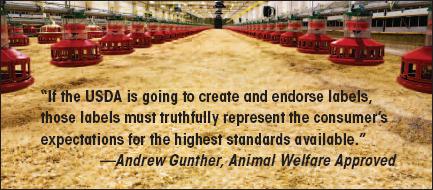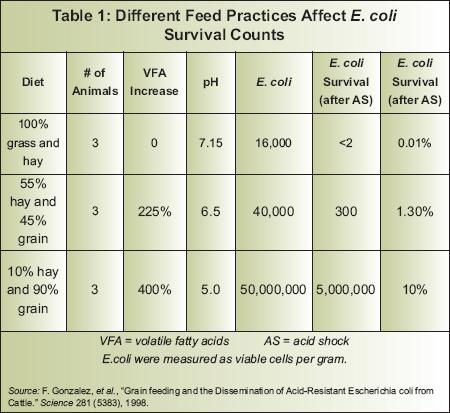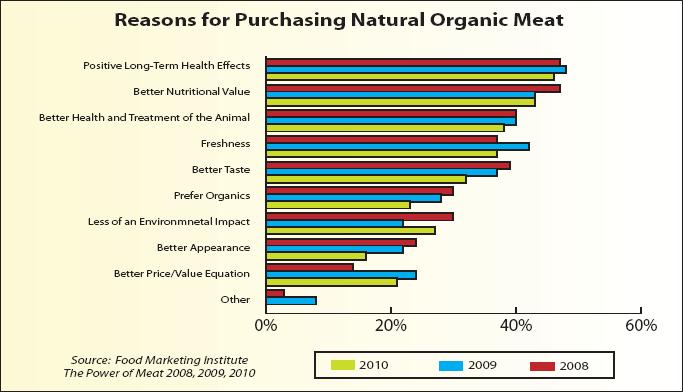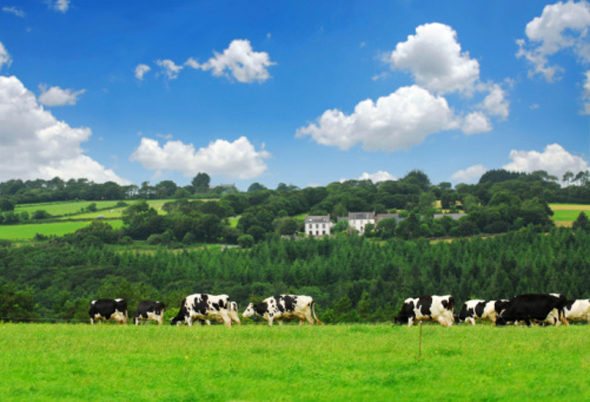In an industry full of vegans, vegetarians, environmentalists, farmers and those opposed to Big Business, the meat and poultry industries often ignite some fiery debates. But, put down your broccoli spears. Natural and organic meat and poultry can offer sustainable sources of food and healthy choices for consumers. Paul Gingerich, meat category director at Albert’s Organics, Bridgeport, NJ, says, “The organic and natural foods industry provides healthy products for those who desire products produced without the use of antibiotics, hormones, growth-promoting drugs and animal byproducts. We believe that these products are having a very positive effect on meat consumption, and are challenging the food industry to take a harder look at some of the additives that they have become accustomed to using.”
Many consumers have limited understanding of the issues surrounding the meat industry. As retailers, you can help clear up the misconceptions and get customers to feel okay about buying meat and poultry again. Pete Basset, national sales and marketing manager for Organic Prairie, La Farge, WI, says, “Protein is a very important part of anyone’s diet and if you are going to eat meat as your protein, you should consume the most nutritious, healthiest meat possible, which is organic meat.” So, before we put meat and poultry out to pasture for good, let’s reexamine the issues.
Fowl Health Issues
We’ve all heard the arguments that eating meat in moderation (rather than carnivorously) can be better for your health, but there are some more controversial health topics related to the meat and poultry industries that are frequently hitting the newsstands. Conventional meat and poultry have been implicated in several health-related conundrums that leave consumers wondering if meat should stay off their menus for good. Here’s why natural/organic, antibiotic- and hormone-free products are growing in popularity.
Antibiotic resistance is becoming a large concern for public health. Factory farm animals tend to be sicker due to overcrowding, less exercise and diets that encourage bacterial infections (more on this, a bit later). According to a recent study, “The industrialization of livestock production and the widespread use of non-therapeutic antimicrobial growth promotants has intensified the risk for the emergence of new, more virulent or more resistant microorganisms. These have reduced the effectiveness of several classes of antibiotics for treating infections in humans and livestock” (1).
On June 28, the U.S. Food and Drug Administration (FDA) issued a draft guidance advising more judicious use of antibiotics in livestock, stating that antibiotic overuse “poses a serious threat to public health,” calling out the overuse of antibiotics for growth-promoting and production purposes as not in the interest of protecting and promoting the public health. FDA has tried to address this issue in the past, but the heavy hands of corporate agriculture have prevented action. As The New York Times aptly puts it, “In the battle between public health and agriculture, the guys with the cowboy hats generally win” (2).
Adele Douglass, executive director of Humane Farm Animal Care, Herndon, VA, says, “If the animals are raised humanely, and not in confinement situations, they do not need to be fed diets with antibiotics in them to prevent disease. Antibiotics should be used only when an animal is sick. Antibiotic use in animals needs to be regulated; they should only be prescribed by a veterinarian, and not be available at the feed store.”
Feeding practices affect the safety of the end product. Ask a five year old what cows eat, and without fail, you will hear the response “grass!”—not grain! Well, the kiddies are right about this one. Gina Asoudegan, director of communications for Applegate Farms, Bridgewater, NJ, says, “Feeding an animal a healthy natural diet protects its health and improves the quality and flavor of the meat it produces. This is particularly true with grass-fed beef. Cattle raised on their natural diet of grass produce meat that’s lower in fat and higher in omega 3s. Grass-fed beef also contains nearly three times the amount of vitamin E and twice the amount of beta-carotene.”
Andrew Gunther, program director at Animal Welfare Approved, Alexandria, VA, adds, “It’s been shown in multiple studies that grass-fed, pasture-based systems lead to less greenhouse gas emissions, a decrease in E. coli 0157:H7, restored wildlife habitats, less manure runoff and pollution, and positive welfare outcomes for animals, farmers and communities.” Industrialized farming depends on feeding the wrong thing to the wrong animal, such as grain and poultry litter to cattle.

A study sought to compare cows on diets of 0, 45 or 90% grain (with the remainder being hay) to determine the potential impact of grain feeding on E. coli in cattle (3). Samples of digesta were obtained from both the rumen and the colon and analyzed for pH, E. coli bacteria count and volatile fatty acids (acetic, proprionic and butyric). The E. coli in the samples were also exposed to an “acid shock” of pH 2.0 for one hour to simulate the human digestive tract. The astonishing results are included in Table 1.
The researchers also found that after cattle had been on a 90% grain diet for some time, when they were switched to an all-hay and grass diet, the number of acid-resistant E. coli was reduced to the same as if they had been on an all-hay and grass diet the whole time: after just five days.
Chickens, too, have some issues regarding their feed. According to Steve Gold, vice president of sales and marketing at Murray’s Chickens, South Fallsburg, NY, “There’s no prohibiting the use of animal byproducts in chicken feed.”
Also, many chickens are fed soy, which raises some concerns related to genetically modified soybeans. An interesting development may be that we will soon see a rise in “soy-free” production. Gingerich says, “Recently soy has taken on some negative connotation. It is my understanding that if soy is properly produced, it can be a benefit to animal production. If soy continues to be an issue in the marketplace, I believe we will have soy-free production as well. Soy provides some very critical protein needs, particularly as it relates to pork and chicken.”
Hamburger recipes don’t include added hormones. What goes into the animal ends up in the food product—and then on your plate and in your body. The European Union Scientific Committee on Veterinary Measures relating to Public Health confirmed in 2007 that “epidemiological data provide convincing evidence for an association between the amount of red meat consumed and certain forms of hormone-dependent cancers” (4). François Baumont, co-founder of Transatlantic Foods, Inc., New York, NY, clarifies the hormone issue: “All meat tissue has natural hormones in it. Added hormones are already illegal in swine and poultry. You wonder why they can still be legal in beef!” Cha-ching. That’s why.
Food safety isn’t always safe. Sometimes, the methods used to create a safe environment for food production are a bit of a paradox. Gunther notes, “With a few exceptions, most agribusinesses are devoted to making their companies seem responsible, not to actually be responsible. Food safety concerns are often dealt with in the most cost-effective way possible, which leads to some real head-scratchers (ammonia in ground beef to kill E. coli?) and the real fear that someone somewhere will force them to make meaningful changes that will disrupt the system. And, they like the system, no matter how many times it is proven to be flawed and unsafe.”
There are better options available, however. Murray’s Chicken uses an electrolyzed water purification system to keep microbe counts in check, says Gold. As opposed to conventional chemicals (that frequently have warning labels), according to Gold, this solution is nontoxic and Murray’s doesn’t need to pre-treat its water before it goes into the town sewer system. He states, “We believe it’s one of the ways we keep our safety issues down pretty low. It’s part of our mission statement to try to do whatever we can that’s safe for the environment and safe for humans.”
The Nouveau Natural
There’s a new wave of mainstreamers trying to cash in on natural and organic meat/poultry. For example, Chipotle Mexican Grill announced on June 7 that all of the beef it uses in its barbacoa, a spicy shredded beef, is now naturally raised, bringing its total of naturally raised beef to nearly 23 million pounds (5). However, although the company prides itself on its mission of “Food with Integrity,” the company no longer serves naturally raised chicken, because “its restaurants can no longer get enough chicken to meet its growing demand” (5)—an excuse that some in the industry just aren’t buying.
“If these restaurant chains are willing to pay the price that ‘natural’ chicken costs, they would find a lot more supply,” says Douglass.
According to Gary Flanagan, president of Shelton’s Poultry, Inc., Pomona, CA, “Companies have to bite the high-cost bullet if they truly offer natural meats and poultry.”
Although the products are more expensive at the present time, the market may be shifting. Gunther says, “We think the laws of supply and demand will exert pressure on the market and more product will become available. Many things will have to change for that to happen, including pastured farmers receiving the same policy support agribusiness receives and a shift in how Americans think of meat and its place in family meals. But, we believe it not only can happen; it is happening.”
And, with mainstream media moguls like Martha Stewart teaming up with companies like all-natural meat producer Niman Ranch, the rest of herd is sure to follow. Gingerich notes that what we don’t want is for growing and processing standards to be lowered to meet the demands of these large retail chains, which put us back in the same cycle of conventional, unhealthy practices.
Asoudegan says, “Conventional farmers are really starting to see that demand for meat raised naturally and organically is not a trend. It’s an evolutionary shift that’s here to stay.”
How Now, “Free-Range” Brown Cow?
The terms “natural” and “organic” are somewhat controversial when it comes to meat and poultry. Flanagan says, “The U.S. Department of Agriculture (USDA) rendered ‘natural’ impotent with its current definition. Natural meat and poultry marketers must resort to negative label claims to make their points.”
|
Halt the Salt
|
Also, under USDA terms, “organic” or “natural” don’t imply anything about an animal’s lifestyle and welfare. Gingerich says, “I do believe that the term natural should be better defined by the USDA. Currently, the USDA recognizes meat products that have no artificial ingredients added to them as a natural product. The USDA does not have a protocol for how the animal is raised. They will only monitor programs that list a specific protocol. Most legitimate natural producers have statements on the packaging that indicate the no antibiotics, no hormones, not fed animal by-product standards. Consumers should look closely at claims made on packaging.” Retailers, too!
Many consumers and retailers might assume that all certified organic meat/poultry are raised outside in a green idyllic paradise, and especially those labeled as “free range.” But, sadly, this is not so. In fact, the term “free-range” is not defined under the National Organic Program’s standards: “There are no restrictions on use of other truthful labeling claims such as ‘drugs or growth hormones used,’ ‘free range’ or ‘sustainably harvested (6). The USDA, however, defines “free range” or “free roaming” as simply: “Producers must demonstrate to the Agency that the poultry has been allowed access to the outside” (7). Technically, this means there only has to be a door leading to the outside of an animal’s indoor confinement (which may be a small concrete area), but the animals don’t actually have to walk through that door to meet the requirements. So, when someone purchases poultry products labeled “free range,” the birds may never have actually seen the light of day.
Gunther adds, “The USDA free-range label doesn’t mean much at all. When my staff goes to conferences and public events, they often take a photo of ‘free-range’ birds and the public is always shocked, because what the photo shows is a massive chicken warehouse, filled with thousands upon thousands of birds. Somewhere in that building, we tell people, is a little door that leads to a small yard. People can’t believe that’s what ‘free range’ really means and they end up feeling conned.”
There are companies that don’t abuse the USDA’s [lack of] standards in this area. Gold says, “We try to give the chicken the atmosphere that nature would give them with lighting, with water, with feed—nothing is forced upon them. The lights go off so they can sleep.” He adds that some farms will leave the lights on up to 22 hours a day so that the chickens will continue to eat and grow. He also says that at Murray’s, the chickens get more room than in conventional chicken houses to “do what chickens do”—roam and flap around, sit and lie down if they want, to peck…and maybe even meet the new rooster.
Retailers, before bringing a particular brand into your store, first decide what your stance on these issues is, and then confirm with companies if their product matches your philosophy.
Gingerich sheds a different light on the issue: “It is my understanding that the USDA is still finalizing the definition of free range. In large part, I agree with the ruling. The issue is far more complex than most of the general public will understand. Animal welfare must always be a consideration. Colorado, for example, has a lot of wonderful rangeland, but one cannot expect cattle to range successfully on land that is covered with 36 inches of snow. Drought is also an issue that must be addressed. In large part, free-range regulation needs to be steeped with a lot of common sense and driven by what is best for the animal.”
Another labeling snafu occurs when the term “humane” is merely used as a way to entice customers to buy. Be wary, for the term’s definition can vary greatly. Gunther says, “Food labels are designed to represent what a consumer wants, but most are meaningless and it just leads to a lack of trust.”
Humane Farm Animal Care has standards to help define “humane.” The Certified Humane Raised & Handled program from HFAC is a farm animal welfare and food labeling program dedicated to improving the welfare of farm animals in food production in all stages of the animal’s life including handling and slaughter. According to www.certifiedhumane.org, to be certified, the program’s standards require that animals have ample space, shelter and gentle handling to limit stress and additionally require that:
• The use of growth hormones and antibiotics is prohibited;
|
Select Meat and Poultry Products
|
• Livestock have access to sufficient, clean, and nutritious feed and water;
• They must have sufficient protection from weather elements and an environment that promotes well being;
• Managers and caretakers must be thoroughly trained, skilled and competent in animal husbandry and welfare, and have good working knowledge of their system and the livestock in their care.
Gingerich notes, “It is extremely important to inform consumers that just because a product is stamped with ‘natural,’ it does not mean it has met the above protocol.” Store owners need to stay informed. He says, “We provide retailers of our Heartland Meadow natural meats with brochures that they place at the point of sale, or on the meat counter, so shoppers can gain a detailed understanding of the product they are purchasing.”
Another organization, Animal Welfare Approved (AWA), offers transparency and consistency for consumers, farmers and retailers. AWA is a third-party certification label that publishes its standards freely and openly and maintains regular contact with its farmers with AWA auditors visiting farms in the program once a year at minimum. In other programs, says Gunther, it might be as many as three years between audits. “A lot can happen in three years,” he says.
AWA standards are based on science and a technical team’s expertise that can help farmers make the transition to a pasture-based system in a way that is safe and efficient. “Our mission is for AWA farmers to be able to generate income from their farms without compromising the welfare of their animals, their land or their families,” says Gunther. Once in the program, farmers can consult with AWA staff about any number of issues regarding their animals and their farm, including labeling and marketing support.
Asoudegan says, “There’s a bit of guilt associated with eating meat products like hot dogs and deli meats because they’re not sure what’s in them or how they’re made. By pulling back the curtain on these products, and letting consumers see the type of clean ingredients we use, we can make consumers feel good about eating the type of foods we all love to eat.” WF

References
1. M. Gilchrist, et al., “The Potential Role of Concentrated Animal Feeding Operations in Infectious Disease Epidemics and Antibiotic Resistance,” Environ Health Perspect. 115 (2), 313–316 (2007).
2. G. Harris, “Antibiotics in Animals Need Limits, FDA Says,” The New York Times, page A15, June 29, 2010, www.nytimes.com/2010/06
/29/health/policy/29fda.html, accessed June 29, 2010.
3. F. Gonzalez, et al., “Grain feeding and the Dissemination of Acid-Resistant Escherichia coli from Cattle.” Science 281 (5383), 1998.
4. “Opinion of the Scientific Panel on Contaminants in the Food Chain (CONTAM) Related to Hormone Residues in Bovine Meat and Meat Products,”The EFSA Journal 150 (2007), www.efsa.europa.eu/en/scdocs/doc/s510.pdf, accessed June 30, 2010.
5. Chipotle Mexican Grill press release, June 7, 2010, http://phx.corporate-ir.net/
phoenix.zhtml?c=194775&p=irol-newsArticle&ID=1435288&highlight=, accessed June 30, 2010.
6. National Organic Program Organic Labeling and Marketing Information, www.ams.usda.gov/
nop, accessed June 29, 2010.
7. United States Department of Agriculture, “Meat and Poultry Labeling Terms,” www.fsis.usda.gov/factsheets/Meat_&_Poultry_Labeling_Terms/index.asp, accessed June 18, 2010.
Published in WholeFoods Magazine, Aug. 2010 (epub July 22, 2010)









